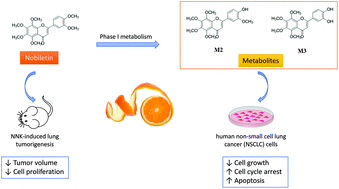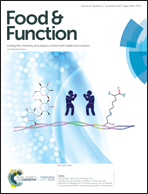Inhibitory effects of nobiletin and its major metabolites on lung tumorigenesis
Abstract
Nobiletin (NBT), a citrus flavonoid, has been associated with various health benefits. Herein, we investigated the chemopreventive actions of NBT and its metabolites in a pulmonary carcinogenesis mouse model and human lung cancer cells. In 4-(methylnitrosamino)-1-(3-pyridyl)-1-butanone (NNK)-treated mice, the oral administration of NBT significantly suppressed lung tumorigenesis as evidenced by reduced tumor volume compared to the control mice. NBT also greatly attenuated cell proliferation in the lung of NNK-treated mice. Our previous study has identified three major metabolites of NBT, namely, 3′-demethylnobiletin (M1), 4′-demethylnobiletin (M2), and 3′,4′-didemethylnobiletin (M3). In this study, we further determined the inhibitory effects of NBT and its metabolites on human non-small cell lung cancer (NSCLC) cells and the underlying mechanisms of action. Interestingly, we found that M2 and M3 exerted much stronger growth inhibition on both H460 and H1299 cells, compared to their parent compound NBT. Flow cytometry and western blotting analysis revealed that M2 and M3 caused significant cell cycle arrest and cellular apoptosis and profoundly modulated multiple proteins associated with cell proliferation and cell death, including p21, cyclin B1, CDK1, cyclin D1, CDK6, CDK4, Bax, cleaved caspase-1, and cleaved PARP. Overall, our results demonstrated that the oral administration of NBT significantly inhibited lung carcinogenesis in mice, and these chemopreventive effects could be attributed to its metabolites that showed potent anti-cancer effects.



 Please wait while we load your content...
Please wait while we load your content...